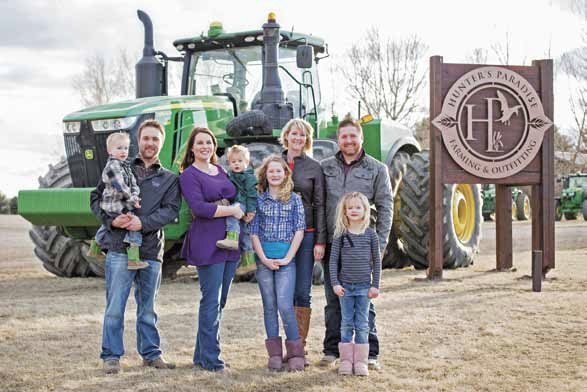Dave and Cherilyn Nagel farm with Dave’s brother, Mike, and his wife, Natalie, near Mossback, Sask. The brothers have lived and worked on the grain farm all their lives and grow durum wheat, canola, Kabuli chickpeas and large green lentils.
The Nagel family added pulses to the rotation about 15 years ago. It was challenging to make a profit with any of their other crops, primarily durum wheat, malt barley and some yellow mustard.
“This was especially true at the time when the wheat board was controlling our cereals — our primary crops,” said Dave Nagel. “We were really having trouble making a profit in the early 2000s.” They decided to try pulses to generate cash flow and profit.
Read Also

Fertilize the crop, not the atmosphere
There’s a lot of interesting science about how nitrogen behaves in the soil. If you have a techie disposition, you’ll…
They chose Kabuli chickpeas and large green lentils, as they tend to be two of the more drought-tolerant pulses. They would fit nicely with the weather conditions often found in the Mossbank area. Even in the exceptionally dry summer of 2015, they did just fine.
“The yields were down maybe 25 percent, but we still did quite well. These two crops are usually the most vulnerable to grading issues, but we had great quality last year.”
“Pulses have primarily been our biggest money-maker on our farm. We also found since we started putting pulses in our rotation, our yields in our other crops, both durum and canola, have come up as well.”
A common theme when talking to pulse growers is the concern over disease in their crops. Dave Nagel has found this a challenge too. They are managing it with a three-year crop rotation: growing durum, then a pulse crop, followed by canola, and then durum back on the canola.
“This has helped with disease management. We introduced fungicides into our program a lot more heavily. It’s important to be aware of the groups of fungicides and applying them in a rotation so we don’t come up with resistance.”
Concerns from the outside world
Another concern is Canadian pulse growers’ complete reliance on export markets and the impact world events can have on the Canadian market. “We do have a domestic market and it’s growing, but I would real ly l ike to see that increase some more to mitigate some of that risk,” said Nagel.
The primary markets for the Nagel’s crops are South America for the lentils and India, Pakistan and increasingly Europe for the chickpeas.
Another major concern for Nagel is the loss of consumer confidence in production practices. “There’s a definite disconnect with how the consumer feels about our practices and if they’re actually safe or not. We are not growing a ‘Frankencrop’. I think we need to demonstrate that we are producing safe, healthy food.”
The commitment to doing more to tell agriculture’s story runs in the family. Nagel said his wife and partner, Cherilyn, calls herself an active “levy payer” and attends various industry meetings on behalf of their farm business. As well, she is very involved in her work with Farm & Food Care Saskatchewan as an advocate trainer for the agriculture
Speaking with Nagel, it becomes clear that farming and growing pulses is more than just a profitable business for him and his family.
“It’s a great feeling to be part of agriculture because it is such a major contributor to the economy, especially in rural areas. We are quite proud to be employing people on our farm and to be part of the agriculture value chain.”
Nagel’s pride in the many levels of the agricultural industry based in Saskatchewan is evident. They are actively supporting the supply chain on their farm including machinery manufacturers and dealers, input suppliers and even the fertilizer being produced in Saskatchewan
“When we’re farming, we’re supporting all these companies along the value chain, even the energy industry,” says Nagel. “It’s nice to have that money stay in rural areas because I feel without agriculture those communities would disappear.”
The road ahead
When asked what he sees in the future, Nagel’s wish list is clear. “I hope to see an increase to domestic demand in this International Year of Pulses and an increased awareness of pulses as a great source of protein in everyone’s diet.”
Going forward Nagel sees a need for a greater investment in research into new varieties as well increased processing capacity.
“We have had, especially in lentils, a huge increase in production. Take a look back at canola as an example — if pulse acres are going to continue to expand, like canola did, the processing has to come up like it did with canola,” said Nagel.
The Nagels do a lot of on-farm cleaning, which allows them to ask a premium on their contracts and ship out clean grain. While they have delivery options within about an hour of their farm, Nagel sees an ongoing issue. “In a year with high prices and the acres that are going in, one of the bottlenecks is going to be capacity to process.”
However, there is a lot to be proud of. “What I’m most proud of is the improvement in our land. It has been a really good outcome with the implementation of pulses in our crop rotations. We’re seeing such an improvement in our land and it’s going to be a great way to leave it for the next generation.”
Growing pulse crops has created a sustainable business for the Nagel family.
It has provided economic and environmental sustainability for the farm and created a promising future for the next generation. This is the final part of a three-part sponsored content series profiling pulse growers in Canada.
This is the final part of a three-part sponsored content series profiling pulse growers in Canada. Click here for Part 1, Click here for Part 2










